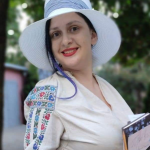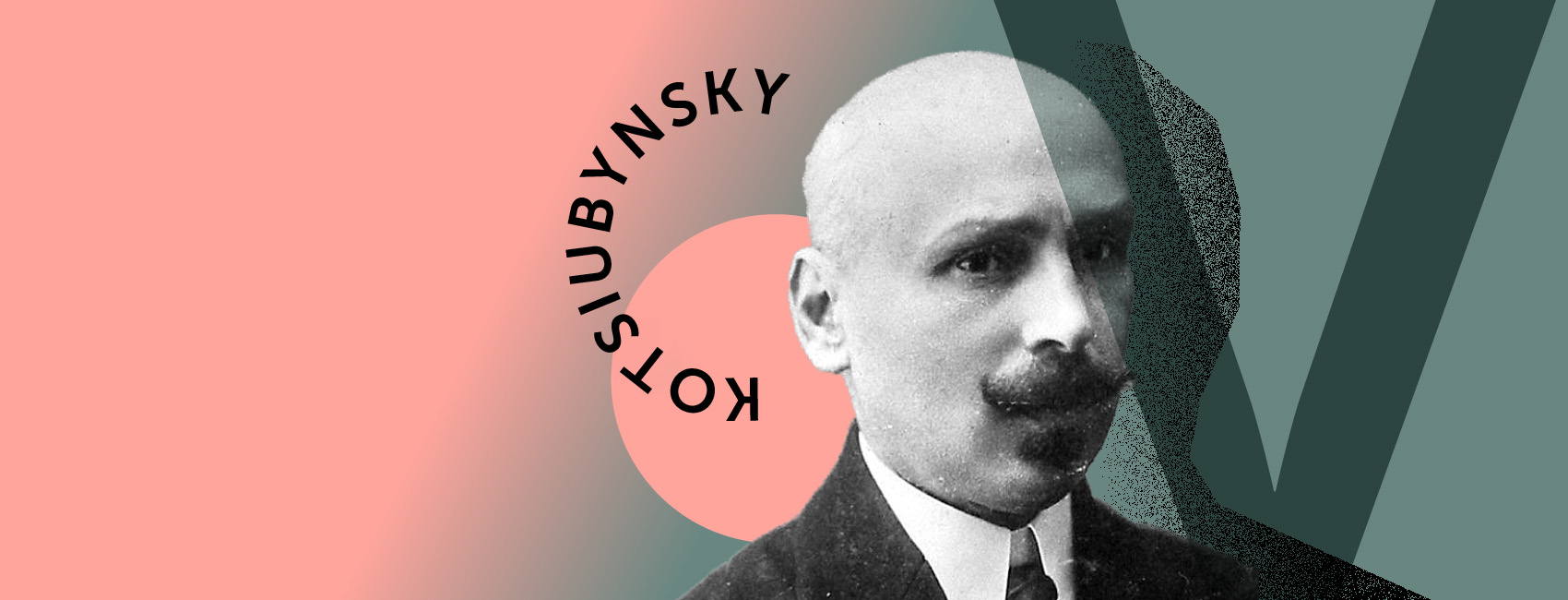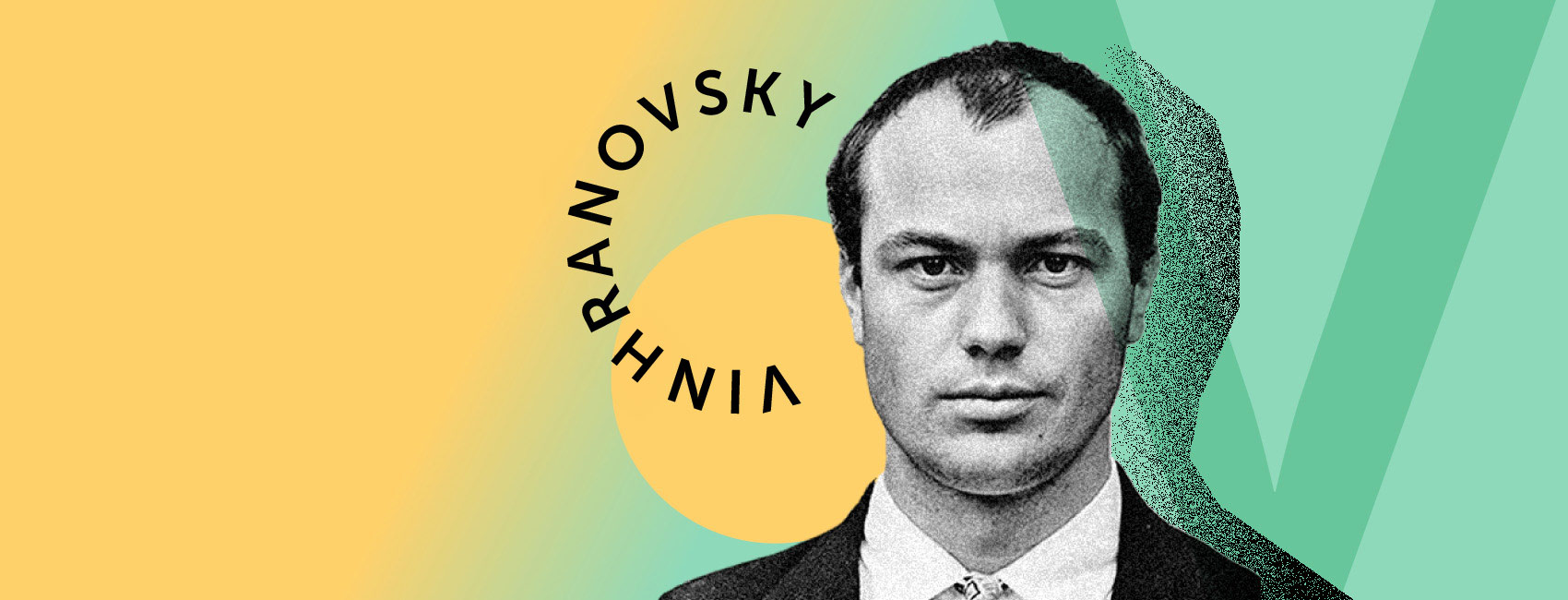* ESC - close the search window
ukrainian classics
Marko Cheremshyna: an ethnographic material in himself and a lark from the Carpathian Mountains
04.05.2024
Marko Cheremshyna, Ivan Semaniuk, Marko Legit, Vasyl Zarenko – these are the names of one person who combined in himself several personas. A writer, who imagined himself a lark, who predicted his own death, who had two birthdays and a real doppelganger. He wrote about rare Hutsul rituals and loved without measure.
He obtained his doctorate in law in Vienna and belonged to the golden age of Galician lawyers. Both in politics and in private life, he did not tolerate pessimism and laziness. He considered his grandfather’s forest to be his place of strength. From the first to the last day of his life, he remained a Hutsul boy with a serious man’s face. He loved nature above all else. All his pen names come from the elements of sun, air, and water.
“Born twice”
Ivan Semaniuk, who would later be known as Marko Cheremshyna, was born in the village of Kobaky in the Carpathian region of Ukraine in 1874. He is known as the “singer of the Hutsul region” (the ethnographic region of the Carpathian Ukrainians).
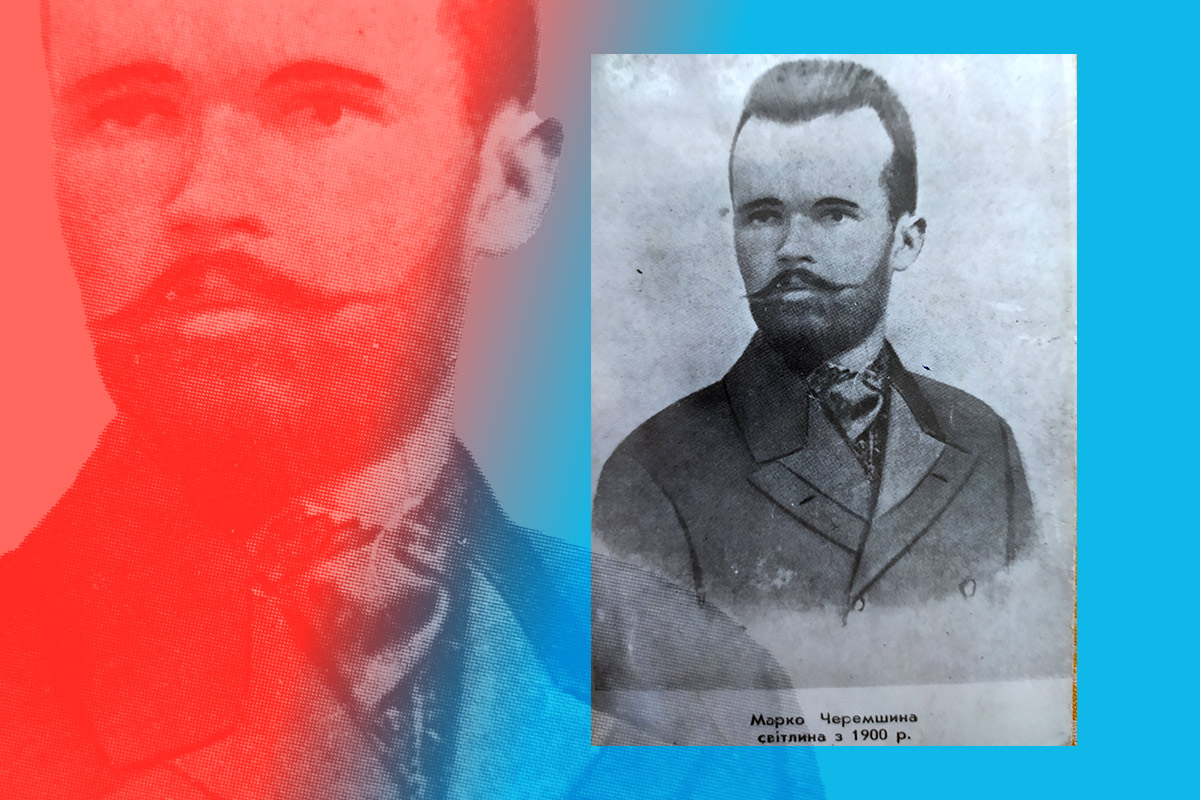
The only surviving photo of Marko Cheremshyna in an embroidered shirt
The future writer was born into the family of Anna Oleksiuk and Yurii Semaniuk as the eldest and most beloved of three children. The boy came into this world “ethnographically”: his own aunt Olena was a midwife, well versed in herbalism, spells, and folk omen reading. It was she who assisted Anna, the mother of the future writer Marko Cheremshyna, in childbirth.
Mother Anna was a universe of lullabies, legends, and stories for her children, and Marko Cheremshyna’s grandfather Dmytro Oleksiuk would later teach his beloved grandson to dance, play the flute, and would tell him every evening about folk culture. Later, Marko Cheremshyna would be asked where he recorded so many customs and how he acquired such a deep knowledge of ethnography. Cheremshyna would answer this question in his book titled “Autobiography”:
…I didn’t collect ethnographic material, because I was that material, I was saturated with folk songs and fairy tales since I was a child. I grew up among songs, fairy tales and flutes, breathing them in and out.
Marko Cheremshyna’s father, Yurii Semaniuk, was also not a simple person. He was a romantic highlander in love with books, who tried to write poetry but never became a writer. He collected books (at a time when even one or two books were rare, he had two cabinets of good literature). He was friends with Yuriy Fedkovych, and he was an initiator and co-founder of the reading house (the first public library at the turn of the twentieth century) in the village of Kobaky.
Young Ivan became a student at the school in Kobaky. He eagerly absorbed the school curriculum, borrowed many books to read at home, and asked for additional lessons. His parents saw that he needed to study further, so he went on to Kolomyia Gymnasium.
RELATED: Mykola Vingranovsky — a poet in poetry, in prose, in life
And here occurred the first biographical mystery of Ivan Semaniuk – his date of birth. On his birth certificate, the date is 13 June 1874; however, this document was issued in 1889, when the young man was already 15 and the date was obviously recorded from verbal, not written, information. In his autobiographical materials and letters, Marko Cheremshyna would later clearly write that he was born on 13 July. Therefore, these two dates – 13 June and 13 July – go hand in hand in his life as the documented date and the one that the writer personally attests to.
At the Kolomyia Gymnasium, the future writer learns a painful lesson in life and dignity. He arrived dressed in a lavish boy’s folk costume (quite expensive, worth noting): but the burgher students and teachers laugh at him, saying that such clothes are good for hauling manure. They also made fun of him for not knowing Polish (although he spoke good German and Russian). Ivan Semaniuk drew some rather peculiar conclusions from this lesson: he learned Polish in six months, on principle, so good that his mocking peers signed up for his paid private Polish lessons. Perhaps this was when the boy’s desire to learn foreign languages was born. At the gymnasium, he would meet people who would become his friends for life.
Ivan Semaniuk created his first literary works at school (mostly under the pen names of Vasyl Zarenko and Marko Legit). He subscribed to many periodicals and dreamed of becoming a writer himself.
Marko Cheremshyna’s School in Vienna
The next step was Vienna. He enrolled at the Faculty of Law (one of the most affordable at the time), although he was not interested in law. He said he studied “for bread,” to get an education and earn money for himself and his family.
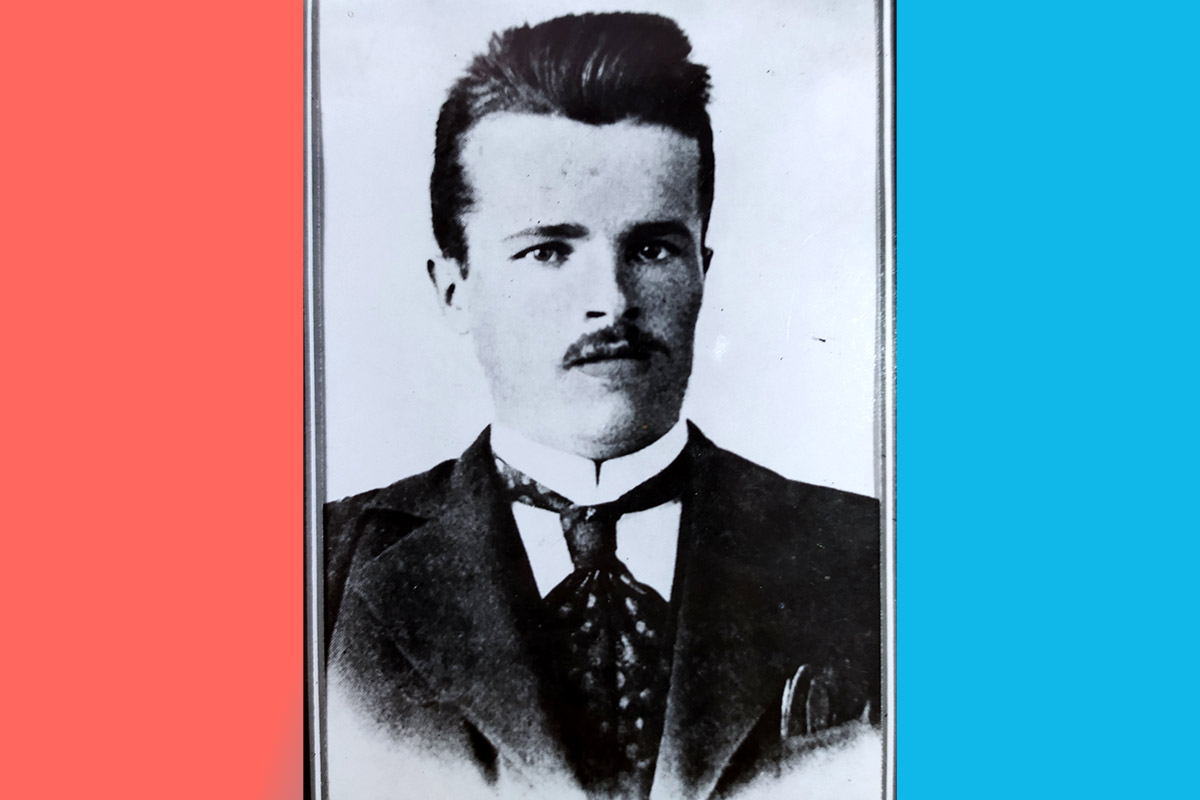
Marko Cheremshyna, a graduate from the University of Vienna
Marko Cheremshyna’s literary fame came during his student years. 1896 was the year of his admission to Vienna University, and the year of his first publication in the “Bukovyna” newspaper – the short story “The Helmsman.” This is when the writer first used the pen name Marko Cheremshyna. Among the writer’s early works was the fairy tale “Bird of Paradise,” published in the Lviv magazine “Dzvinok” (the Bell) in 1897. In this tale, the allegorical bird is attacked by two neighbors, one of whom is the Viper from the East who “would like to devour the whole world.”
Later, this fairy tale would not be included in any edition of Marko Cheremshyna’s works, not even its fragments. For Marko Cheremshyna’s 100th birthday, the writer’s widow and the editorial board did include the tale within the two-volume edition of his works, and they were summoned to the party authorities of the USSR and threatened to remove this work and the short story “Jordan” from the already designed book.
In 1901, Ivan Semaniuk graduated from the University of Vienna and published his first book, “Signs.” Mykhailo Hrushevsky would later say in his review:
“Marko Cheremshyna is one of the most prominent figures of young Ukrainian literature.”
“Ukrainian lawyer”
Marko Cheremshyna’s literary life took a long pause and the persona of Ivan Semaniuk, a lawyer and human rights activist, came forward. Indeed, if you think about it, the time period between Marko Cheremshyna’s first and second books is more than twenty years (1901 and 1925), but this time was not a time of silence. Marko Cheremshyna first became an assistant to the lawyer Mykola Lahodynsky in Deliatyn. Then he opened his own law practice in Sniatyn, and this was the period when he immersed himself in social and political work. He contributed a lot to the organization of public life in the region, spoke at meetings, and immersed in private consulting. He said that everyone in the villages knew him – both the elderly and the young children. He was an expensive lawyer, but for ideological reasons, he defended many people for free and even covered court costs (especially if the case concerned the Ukrainian national question).
RELATED: Mykola Bazhan’s literature juggling and whirlpools of compromises
In Sniatyn, the town that changed his life, Marko Cheremshyna was known as the “Ukrainian lawyer.” The fact is that he was the first and for a long time the only Ukrainian lawyer. Apart from him, Jewish and Polish lawyers worked there.
In Sniatyn, Marko Cheremshyna also met “the most beautiful young lady in all of Galicia” – a beauty from the Karpiuk family, Natalia. An age gap of 17 years existed between them. She was a bright, versatile, talented young teacher. He was a well-known writer whose works Natalia Karpiuk once received as a birthday gift from her father. Marko Cheremshyna fell in love right away and insisted on an immediate marriage. At first, Natalia fell in love not even with him, but with the poetry of his confessions, letters, his efficiency, and reliability. And then she realized that he was her whole world. “I loved my wife beyond measure,” the writer would later confess, and it would be true.
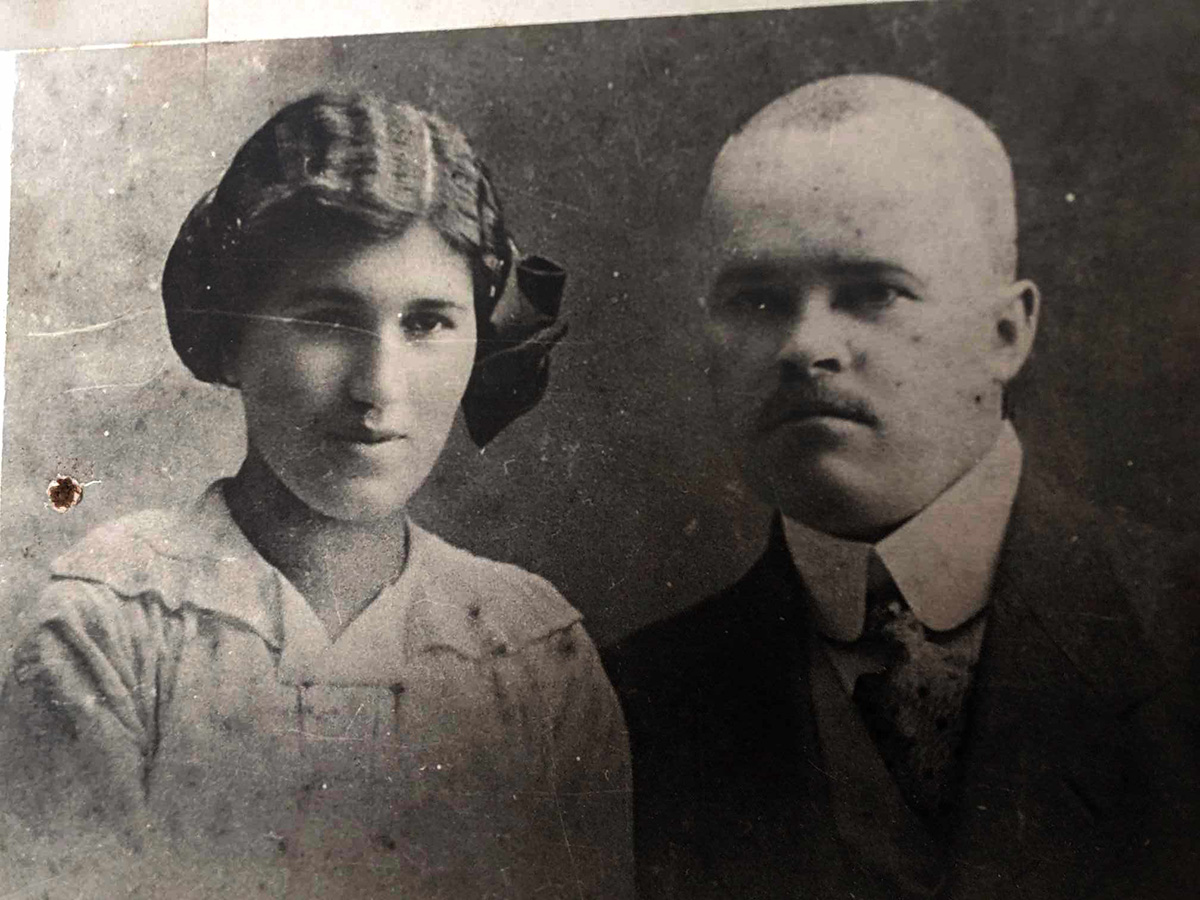
Marko Cheremshyna with his wife Natalia
He was a jealous husband just as Natalia was a jealous wife, although it is difficult to find a hint of at least one other woman in Marko Cheremshyna’s biography. The couple quarreled a lot (and they both were like fire by temperament), but they also made up immediately.
“The village bends”
The year 1914 is perhaps the most contrasting in the life of Marko Cheremshyna. It was happy – because it was the year of his wedding to Natalia – and tragic – because the First World War began.
As soon as the threat of wartime hangs over Sniatyn, Marko Cheremshyna brings Natalia and her two younger sisters, Olha and Mariia, to his parents in the village of Kobaky. However, the war will catch them even there. The stories about the First World War would later form the basis of his collection of short stories, “The Village Bends.” Literary critics will say that this is Marko Cheremshyna’s strongest and scariest book and one of the strongest books written by Ukrainians about the war.
Later, Marko Cheremshyna returned to Sniatyn, immersed himself in volunteer work, helped the families of soldiers defend their rights to compensation, and after the war, he focused on the policy of Ukrainization. He wanted education and paperwork to be in Ukrainian. He was on the district council, was elected Burgomaster of Sniatyn, but later resigned in favor of Semen Zinkevych from Sniatyn: he frankly admitted that it was difficult to combine literature, community service, and politics, and he was not used to doing something with half-strength.

Marko Cheremshyna’s passport photo. He is pictured with his wife
Marko Cheremshyna had one painful scar ahead of him. He and his father both received long-term injuries at the same time (in different circumstances, but the perpetrator is the same). In 1919, Ivan Semaniuk (Marko Cheremshyna) was delegated by the West Ukrainian People’s Republic (a Ukrainian state formed in the Western Ukraine in 1917) to negotiate with the Romanian side, which occupied Pokuttia (a Ukrainian region near the Carpathians) in spring. The negotiations failed, as the Romanians opened fire, and Marko Cheremshyna jumped into a ditch with ice-cold water to escape the bullets and had to wait it out. As a result, the writer had kidney problems for the rest of his life. In the same year, 1919, Romanian troops beat his father almost to death in Kobaky “because of a rifle.” On 20 February 1920, Yurii Semaniuk died of carbon monoxide poisoning in his own home.
The symbolism of sudden death
In the last years of his life, Marko Cheremshyna was fighting against the storm. His house was searched from time to time (the new Polish government did not forgive him for his Ukrainianization policy), and he was experiencing increasingly acute heart and kidney problems. But he was not going to die. At least not at the age of 53. He was going in a cart to visit his mother in Kobaky for Easter, and his wife Natalia was with him. On Easter Monday in Kobaky, the ancestors were commemorated; in Marko Cheremshyna’s time, the commemoration consisted of a meal and gifts at the graves, a rite called “covering the graves.” Although Marko Cheremshyna gave his sister enough money to buy Easter bread and pots for the gift-giving, she made him very sad with her poor gifts. He leaned on a stick, cried, and–died of a heart attack– an ethnographic rite of honoring the ancestors, as if he died in the middle of his own story.
Was he “killed” by stale Easter bread and chipped pots? Given that he had had at least two heart attacks in the courtroom before, and during searches at home, it is unlikely… But that was the last straw.
At that moment, a lark flew into his mother’s room. A bird that hits the windowpane is believed to portend misfortune. Marko Cheremshyna once wrote in “Autobiography” that if he were allowed to change into a bird, he would choose to become a lark. How did he know?
The publication is a part of the “Chytomo Picks: Classics and New Books from Ukraine” project. The materials have been prepared with the assistance of the Ukrainian Book Institute at the expense of the state budget. The author’s opinion may not coincide with the official position of the Ukrainian Book Institute.
Translation: Tetyana Mykolenko
Copy editing: Nicole Yurcaba
Proofreading: Terra Friedman King
This publication is sponsored by the Chytomo’s Patreon community
the more you read, the greater the possibilities
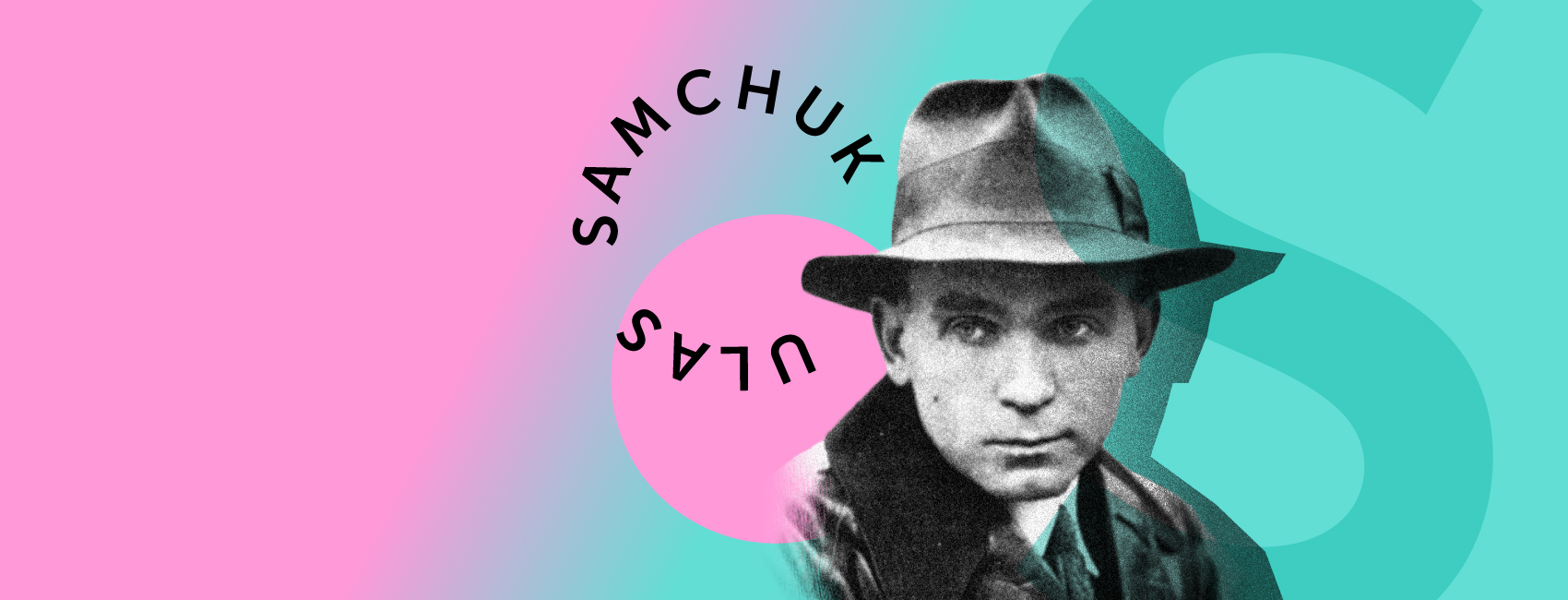
8756
Chytomo Picks
Ulas Samchuk – chronicler of Ukraine through wars, camps, famine, and exile
30.10.2024 - Petro Kraliuk
5735
Chytomo Picks
Vasyl Barka: Conservative modernist and Holodomor survivor
15.10.2024 - Mykhailo Sokulsky